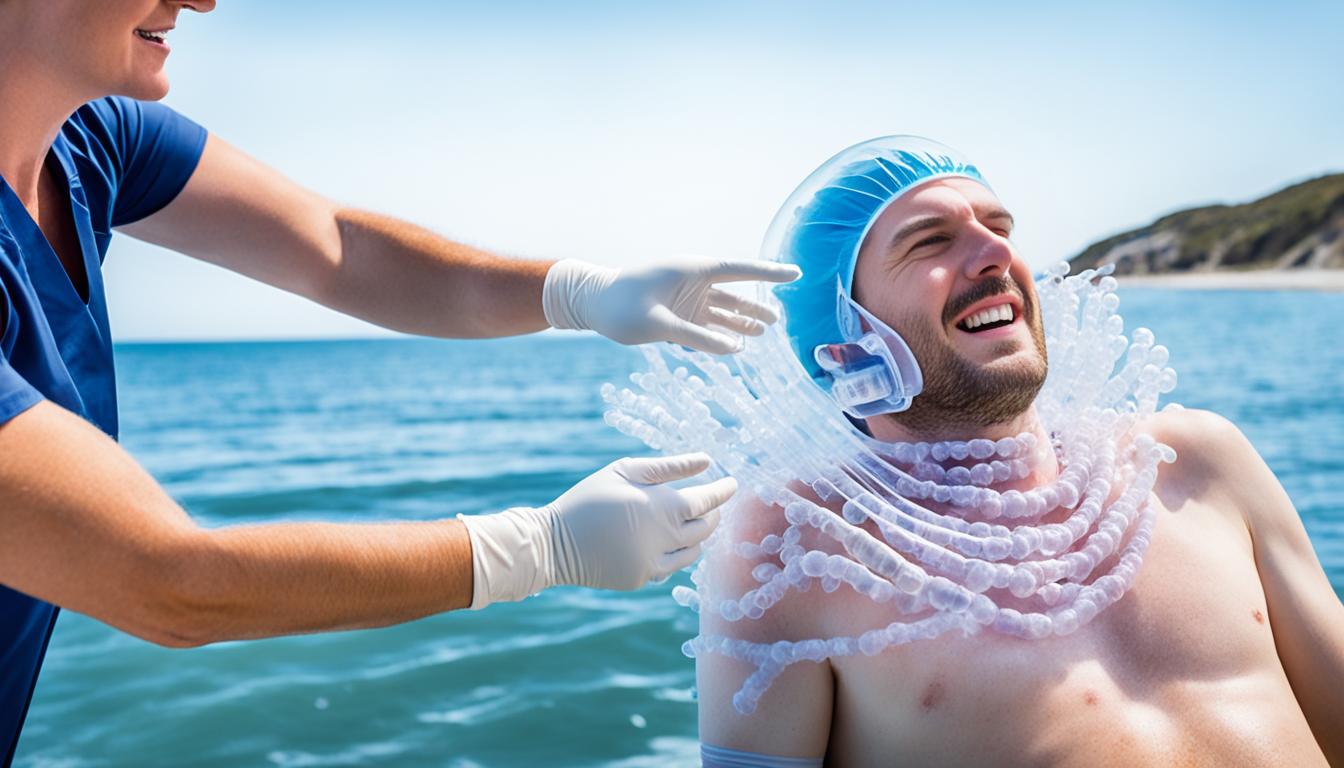Jellyfish stings are very painful. They can cause redness, swelling, and itching where they hit. For some people, stings could lead to trouble breathing or even heart problems. It’s important to act fast to help lessen these effects.
To treat a jellyfish sting, start by gently removing any tentacles from the skin. You can use tweezers or wash with seawater. Never use fresh water, as it might make more venom come out. After the tentacles are off, focus on reducing pain to make the person more comfortable.
New research is improving how we deal with jellyfish stings. Scientists are looking into using stem cell therapy to heal stings better and faster. These new methods are providing hope for a brighter future for jellyfish sting victims.
Key Takeaways:
- Immediate first aid is essential for jellyfish stings, including removing any tentacles and providing pain relief.
- Severe jellyfish stings can lead to difficulty breathing, muscle cramps, and cardiovascular collapse.
- Recent advances in diagnosis and treatment, such as stem cell therapy, show promise in improving outcomes for jellyfish stings.
Understanding Jellyfish Stings and Their Venom
Jellyfish stings happen often in coastal areas and can hurt. Knowing about the types of stings, the venom, and their effects is key to dealing with them.
Jellyfish sting by pushing venom into the skin using special cells on their tentacles. This venom’s toxicity depends on the jellyfish species.
Some jellyfish, like the box jellyfish and Portuguese man-of-war, have very strong venom. Their stings can cause a lot of pain, muscle cramps, and heart issues.
The Science Behind Jellyfish Venoms
Scientists have learned a lot about jellyfish venom. It’s made up of different proteins, peptides, and toxins. These can cause a range of problems from a small red spot to bigger health issues.
The strength of the venom varies. This depends on the jellyfish and the person stung. Knowing more about jellyfish and their venom helps in treating stings and making sure they don’t get too bad.
The Importance of Prompt Medical Attention
Don’t ignore a jellyfish sting, even if it doesn’t seem too bad. It’s important to see a doctor, especially if the symptoms are severe or if there’s an allergic reaction.
Doctors can check how serious the sting is, help with the pain, and give the right treatment. They might take off any tentacles, clean the area, and give medicines to make pain and swelling go down.
Sometimes, using antivenom or specific treatments is needed. What’s done depends on how the sting affects the person and their health history. It’s always important to get help quickly.
Learning more about jellyfish stings is crucial for better care and prevention. Research helps doctors find out new ways to help and protect people from jellyfish stings.
Advances in Diagnosis, Treatment, and Prevention
Jellyfish stings are checked by looking at what symptoms someone has and their jellyfish history. If stung, it’s important to do first aid right away. This includes getting any tentacles off gently and easing the pain.
Vinegar used to be the go-to for jellyfish stings. But, recent research found that hot water or ice packs work better. They help lower pain and swelling from the sting.
It’s also key to prevent jellyfish stings. Wearing protective gear like rash guards or wetsuits keeps jellyfish away. Plus, it’s smart to avoid swimming in places with lots of jellyfish. These steps can really cut down your chance of getting stung.
As for new treatments, scientists are looking into using stem cells for jellyfish stings. Stem cell therapy could help heal faster and lessen the sting’s long-term effects. Even though it’s early, this kind of treatment looks like it could be very helpful.
FAQ
Q: What are the symptoms of a jellyfish sting?
A: Jellyfish stings can be very painful. They cause redness, swelling, and itching at the sting area. In severe cases, people may have trouble breathing or experience muscle cramps. Sometimes, this can even lead to heart problems.
Q: How are jellyfish stings diagnosed?
A: Doctors look at the symptoms you show and your history with jellyfish. This helps them diagnose jellyfish stings.
Q: How should I provide immediate first aid for a jellyfish sting?
A: To help right away, remove any remaining tentacles. Then, try to reduce the pain the person is feeling.
Q: What are some effective treatments for jellyfish stings?
A: In the past, people used vinegar to ease the pain of jellyfish stings. But now, we know that using hot water or ice packs can work better. Both can help with the pain.
Q: How can jellyfish stings be prevented?
A: To avoid jellyfish stings, wear clothes that protect your skin. Also, stay away from places where many jellyfish are.
Q: Are there any recent advancements in treating jellyfish stings?
A: Scientists are looking into using stem cells to treat jellyfish stings. They hope this can heal the wound faster and reduce any lasting damage.

